|
|
|||
|
RUFOUS HUMMINGBIRD |
|
All text & photos © Hilton Pond Center After having hosted Ruby-throated Hummingbirds all summer, master gardener Violet Kelemen took down her sugar water feeder in October 2003. A few ruby-throats continued to visit the abundant nectar plants Violet and husband Leslie had planted throughout their Anderson SC (Anderson County) backyard, but eventually the hummers all disappeared. Imagine Violet's surprise when on 28 November a hummingbird showed up among some of her late-blooming flowers. She quickly made a batch of artificial nectar, re-hung her feeder, and was delighted when the newcomer hummer began dining from it. We arrived in Anderson--just south of I-85 and overlooking the northestern backwaters of Lake Hartwell--and were greeted at 7 a.m. by the Kelemens and Bill and Kitty Neckerman, two other master gardeners who had driven down from Pendleton SC to observe the banding procedure. In about five minutes we'd hung our portable hummingbird trap and placed in it the Kelemens' feeder, but cloud cover made the pre-dawn sky even darker than we expected. This was actually the first time for us to try a new release mechanism we had designed for the trap. In the "old days" (i.e., prior to 2002), we always used a trap that closed when we tugged on a length of fishing line. One drawback of this method was that we had to keep a house door or window open at the host's residence, and on very cold days that was inconvenient and no so great for the heating bill. Last year we graduated to a wireless electronic device called the TrapTripper; it uses a car door lock mechanism and remote button to pull a pin that releases the door on a new trap we designed to accommodate it. The TrapTripper worked well but had a slight delay on the release, was a tad heavy for portability, and needed to be charged frequently, so we pondered how the whole apparatus might be improved. Just as building a better mousetrap is an admirable goal for inventors, so is designing the "ultimate" bird trap for hummingbird banders.
Last summer, we went to neighboring Bethany SC to the home of Barry Benton, where we banded a leucistic (white) hummingbird. Barry is a model car enthusiast and was quite interested in how the hummingbird trap worked. When we described several improvements we desired, Barry suggested we try a lightweight and fast-acting servo motor used to steer model cars and airplanes. Eventually we visited our local hobby shop, bought a transmitter, receiver, and servo motor, and adapted it to the portable hummingbird trap. After attaching the required AA batteries, we tested the device several times and determined it was just what we'd been looking for. (By the way, don't try building this set-up at home. It's against state and federal laws to catch hummingbirds without proper training and a permit.)
That brings us back to the Kelemens' house in Anderson, where we were to conduct our first real test of the new trap mechanism. By 7:05 a.m. the trap and feeder were in place, so we joined everyone idoors to watch for the local hummingbird. The sky gradually lightened and we imagined that we saw the hummer a couple of times before confirming its first visible trap visit at 7:25 a.m. As often happens, the bird tried to get in from the back of the trap, likely because the feeder within is closer to that end; i.e., further away from the trapdoor. In short order the hummer flew to the front of the trap--which was obscured from our view by a pole--and then flew off. A few minutes later the bird returned but again failed to enter the trap, at which point the Kelemens and Neckermans--who were watching from a different angle--correctly discerned that it was highly unlikely that the hummingbird would enter the trap because the trapdoor wasn't open. It appears that when we hung the trap our new release mechanism wasn't adjusted quite right, and the door had closed on its own. Suffering from frustration and embarrassment, we went back outside, made a minor adjustment on the mechanism's pull-pin, and returned to the living room to see if the bird would return. Thankfully, it did, so as soon as it entered the trap we flipped a lever on the transmitter, causing the servo motor to turn, the release pin to move, and the trapdoor to slide shut just as we had planned. Despite the initial fickleness of our high-tech device, we had trapped another vagrant hummingbird.
We could see through the trap that the hummer had a small amount of rust at the base of its tail and not much brown color elsewhere, so our first diagnosis was that it was a female Selasphorus hummer, most likely a Rufous (S. rufus) but possibly the smaller and far less common Allen's Hummingbird (S. sasin). To verify its species, age, and sex, we took it inside the Kelemens' residence and set up shop on their dining room table. Using a chart based on measurements from hundreds of known-species, known-age, known-sex hummingbirds (Pyle et al., Identification Guide to North American Birds), we worked through the possibilities. The wing chord was 43.1mm, which ruled out the possibility that the bird was a somewhat smaller male Selasphorus whose wing chord would have ranged from 38.1-42.5mm in a Rufous and 36.2-39.9mm in an Allen's. Usually, the wing chord is also diagnostic in separating Rufous and Allen's females but the Kelemens' bird posed a problem: a female Rufous wing ranges 42.6-46.6mm, while a female Allen's ranges 39.5-43.3mm. Our 43.1mm measure was at the high end for Allen's but also fell within range for a Rufous. That meant we needed to make additional measurements.
The culmen (exposed bill length) wasn't conclusive, either, but fortunately the bird had a tail 28.0mm long--considerably longer than the maximum expected Allen's tail length of 25.9mm. A final check of the width of the outmost tail feather came in at 4.0mm and--since the Allen's fifth tail feather is quite narrow (only up to 3.3mm)--we felt confident in finally concluding that the Kelemen bird was a female Rufous. The shape of the rectrices (tail feathers)--along with their color patterns--indicated the bird was an adult that must have hatched out prior to the summer of 2003. It was also interesting that this particular hummer dropped several of her rectrices during the banding and measuring process (top photo), something that occasionally happens and that we suspect is more prone to happen with a bird that is preparing to replace those feathers anyway. Thanks to Violet and Leslie for allowing us to visit and trap their winter hummingbird, and for delicious apres-banding snacks that refueled us as we completed our work. The Kelemens are natives of Hungary--where hummingbirds do not occur--and Violet's poppy seed pastries from the old country were especially tasty. Vital Statistics for All text & photos © Hilton Pond Center
If you're interested in sharing your hummingbird observations and learning from other enthusiasts, you may wish to subscribe to Hummingbird Hobnob, our Yahoo!-based discussion group. Also be sure to visit our award-winning Web site for Operation RubyThroat: The Hummingbird Project; on it you'll find almost anything you want to know about hummingbirds, including more information about Hummingbird Banding.
For much more information about hummingbirds, visit: |
|
Make direct donations on-line through
Network for Good: |
|
|
LIKE TO SHOP ON-LINE?
Donate a portion of your purchase price from 500+ top on-line stores via iGive: |
|
|
Use your PayPal account
to make direct donations: |
|
|
Back to Vagrant & Winter Hummingbird Banding Back to This Week at Hilton Pond Back to What's New? Current Weather Conditions at Hilton Pond Center |
|
Join the |
|
post questions for The Piedmont Naturalist |
Join the |
Search Engine for |
|
|


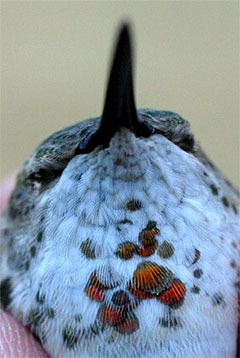 Violet reported her winter vagrant to Hilton Pond Center by E-mail on 30 December, and we immediately made plans to visit with in-laws in Greenville so we'd have just a 30-minute drive for a banding expedition early on 3 January.
Violet reported her winter vagrant to Hilton Pond Center by E-mail on 30 December, and we immediately made plans to visit with in-laws in Greenville so we'd have just a 30-minute drive for a banding expedition early on 3 January.
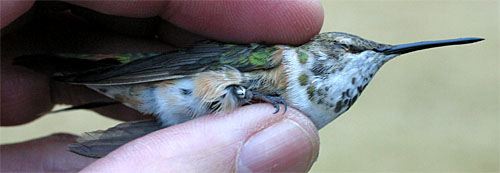
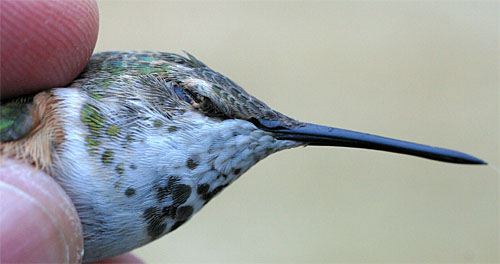
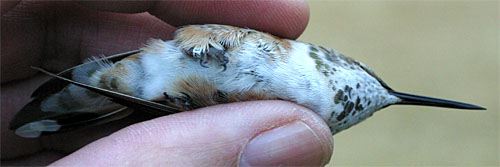
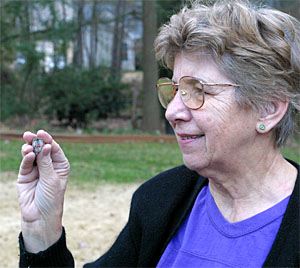 The Rufous Hummingbird at Anderson will bring in new tail feathers in the coming weeks prior to migrating back to her ancestral breeding grounds in southern Alaska, western Canada, or the northwestern U.S.
The Rufous Hummingbird at Anderson will bring in new tail feathers in the coming weeks prior to migrating back to her ancestral breeding grounds in southern Alaska, western Canada, or the northwestern U.S.
 Students at GLOBE-certified schools may submit winter hummingbird observations as part of Operation RubyThroat and GLOBE. Students can also correlate hummingbird observations with data on abiotic factors, including atmosphere, climate, hydrology, soils, land cover, and phenology. See the
Students at GLOBE-certified schools may submit winter hummingbird observations as part of Operation RubyThroat and GLOBE. Students can also correlate hummingbird observations with data on abiotic factors, including atmosphere, climate, hydrology, soils, land cover, and phenology. See the 



